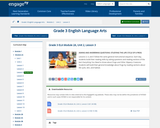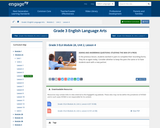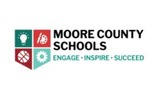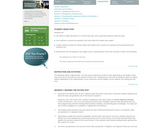
Students read a passage and answer questions based on the passage. An answer key is included.
- Subject:
- English Language Arts
- Material Type:
- Activity/Lab
- Provider:
- K12 Reader
- Author:
- K12 Reader
- Date Added:
- 02/26/2019

Students read a passage and answer questions based on the passage. An answer key is included.

In this lesson, students continue to build their reading skills by asking questions and reading sections of the text, Everything You Need to Know about Frogs and Other Slippery Creatures. Students continue to build their general knowledge about frogs by reading selections about life cycle, skin, and habitat.

In this lesson, students build their reading skills by asking questions and reading sections of the text, Everything You Need to Know about Frogs and Other Slippery Creatures. Students build their general knowledge about frogs by reading selections about life cycle, skin, and habitat.

In this lesson, students continue to build their reading skills by asking questions and reading sections of the text, Everything You Need to Know about Frogs and Other Slippery Creatures. Students continue to build their general knowledge about frogs by reading selections about life cycle, skin, and habitat.

This resource, which is a direct download, is a lesson plan for "Aero and Office Mike" by Joan Plummer Russell. "Aero and Officer Mike is an informational text about a police officer and his partner, a dog named Aero. Information about their daily routine, Aero's special talents, and Officer Mike's training is included.

Students read about Elijah McCoy, an African American inventor and answer questions to help improve their comprehension. An answer key is included.

Students read about Lewis Latimer, an African American inventor and answer questions to help improve their reading and comprehension skills. An answer key is included.

Students read about Patricia Bath, an African American inventor and answer questions to help improve their reading and comprehension skills. An answer key is included.

This resouce contains a lesson plan to use with The Albertosaurus Mystery written by Philip Currie.

In this lesson, collaborative groups will read a variety of American tall tales, then report elements of their story to the whole class. Students add story information to a collaborative, whole-class character study matrix that summarizes all the stories. In a writing activity, students compare two characters of their choice. The lesson process is applicable to any set of related texts.

Learn how to identify explicit evidence and understand implicit meaning in a text.You will be able to answer questions about informational text and refer explicitly to the text to support your answers.

Can your group make a balloon to look like a favorite book character, famous person or Superhero which will be driven by a Sphero and Sphero Chariot?

This lesson supports the use of a text set (paired fiction and nonfiction texts on a similar topic) to increase student interest in and understanding of content area material and to develop critical writing skills. The more familiar format of narrative fiction introduces the topic and generates confidence in exploring the less familiar genre of nonfiction. Students then demonstrate what they have learned about the topic and about genre by writing an original piece that blends together narrative and expository elements.

This resource uses google slides to allow students to set a quarterly reading goal, choose from a variety of “book finisher activities,” and make a slide for each book. Students complete an activity from the choice board, which is aligned to 3rd grade R.L. and R.I. standards, and then complete the activity on a google slide.

In this lesson, students will learn about accessibility and the value of empathy through brainstorming and designing accessible solutions for hypothetical apps.

Students examine books, selected from the American Library Association Challenged/Banned Books list, and write persuasive pieces expressing their views about what should be done with the books at their school.

In this minilesson, students explore the use of dialogue tags such as “he said” or “she answered” in picture books and novels, discussing their purpose, form, and style. Students identify dialogue tags in stories, collaboratively revise a passage from a novel to add more variety to the tags, and then apply the text structure to stories that they have written.

This lesson introduces a new kinesthetic vocabulary activity (see Part B of Work Time). Students basically act out sentences from this section of Bullfrog at Magnolia Circle.

In this lesson, students continue close reading of pages 8-11 and 16-25 of Bullfrog at Magnolia Circle.

This lesson focuses on helping students to synthesize main ideas about the bullfrog. It also helps them to see how page 32 differs (in structure, style, and purpose) from the other pages of Bullfrog at Magnolia Circle.